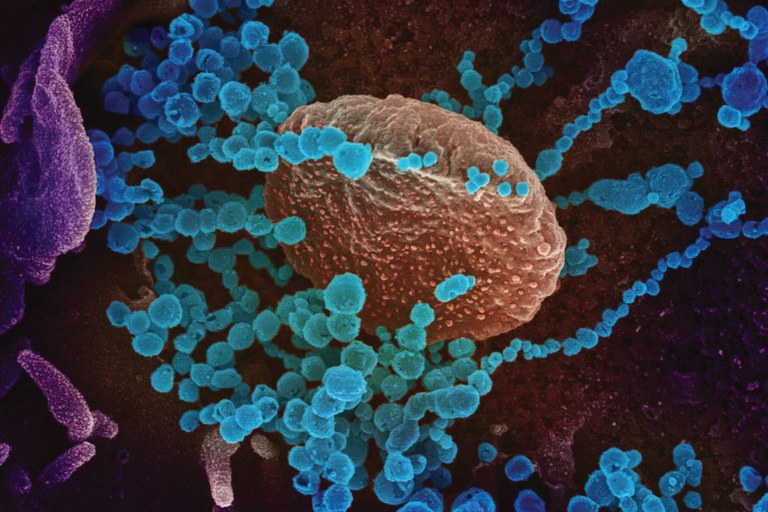Posted: December 2, 2022
New tool predicts changes that may make COVID variants more infectious.

This scanning electron microscope image shows SARS-cov-2 (round blue objects) emerging from the surface of cells cultured in the lab. The virus shown was isolated from a patient in the U.S. Credit: Institute of Allergy and Infectious Diseases
As SARS-CoV-2 continues to evolve, new variants are expected to arise that may have an increased ability to infect their hosts and evade the hosts' immune systems. The first key step in infection is when the virus's spike protein binds to the ACE2 receptor on human cells. Researchers in the college and their colleagues have created a novel tool that can predict with reasonable accuracy the specific amino acid--or protein building block--changes in the virus's spike protein that may improve its binding to human cells and increase the virus's infectiousness.
The tool could enable the computational surveillance of SARS-CoV-2 and provide advance warning of potentially dangerous variants with an even higher ability to bind to human cells. This can aid in the early implementation of public health measures to prevent the virus's spread and perhaps may even inform vaccine booster formulations.
"Emerging variants could potentially be highly contagious in humans and other animals," said Suresh Kuchipudi, clinical professor of veterinary and biomedical sciences and associate director of the Animal Diagnostic Lab. "Therefore, it is critical to proactively assess which amino acid changes may likely increase the infectiousness of the virus. Our framework is a powerful tool for doing this."
The team used a novel, two-step computational procedure to create a model for predicting which changes in amino acids may occur in the receptor binding domain of SARS-CoV-2's spike protein that could affect its ability to bind to the ACE2 receptors of human and other animal cells. The findings were published in the journal Proceedings of the National Academy of Sciences.
Kuchipudi added, "SARS-CoV-2 can switch hosts as a result of increased contact between the virus and potential new hosts. This tool can help make sense of the enormous virus sequence data generated by genomic surveillance. In particular, it may help determine if the virus can adapt and spread among agricultural animals, thereby informing targeted mitigation measures."
--Sara LaJeunesse
Features
Fostering Forests
Across the United States, forests face unprecedented threats, and scientists in Penn State's College of Agricultural Sciences are conducting novel and complex research to conserve them.
Buzzing With Purpose
Community scientists work to protect Pennsylvania's wild bees
Conservation Reimagined
Exploring new approaches to cope with a changing climate


